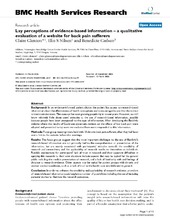| dc.contributor.author | Glenton, Claire | eng |
| dc.contributor.author | Nilsen, Elin S. | eng |
| dc.contributor.author | Carlsen, Benedicte | eng |
| dc.date.accessioned | 2006-11-20T18:20:13Z | |
| dc.date.accessioned | 2020-12-10T06:24:48Z | |
| dc.date.available | 2006-11-20T18:20:13Z | |
| dc.date.available | 2020-12-10T06:24:48Z | |
| dc.date.issued | 2006-03-15 | eng |
| dc.identifier.issn | 1472-6963 | |
| dc.identifier.uri | https://hdl.handle.net/1956/1953 | |
| dc.description.abstract | Background: In an evidence-informed patient choice the patient has access to research-based information about the effectiveness of health care options and is encouraged to use this information in treatment decisions. This concept has seen growing popularity in recent years. However, we still know relatively little about users' attitudes to the use of research-based information, possibly because people have been unexposed to this type of information. After developing the BackInfo website where the results of Cochrane systematic reviews on the effects of low back pain were adapted and presented to lay users we evaluated how users responded to this information. Methods: Focus group meetings were held with 18 chronic back pain sufferers, after they had been sent a link to the website before the meetings. Results: The focus groups suggest that the most important challenges to the use of BackInfo's research-based information are not primarily tied to the comprehension or presentation of the information, but are mainly associated with participants' attitudes towards the credibility of research and researchers, and the applicability of research results to themselves as individuals. Possible explanations for participants' lack of trust in research and their apparent difficulties in applying this research to their own situations include aspects that may be typical for the general public including the media's presentation of research, and a lack of familiarity with and feelings of distance to research evidence. Other aspects may be typical for patient groups with chronic and unclear medical conditions, such as a lack of trust in the health care establishment in general. Conclusion: In order to enhance the credibility and applicability of research evidence, providers of research-based information could explore a number of possibilities including the use of including personal stories to illustrate the research outcomes. | en_US |
| dc.format.extent | 300163 bytes | eng |
| dc.format.mimetype | application/pdf | eng |
| dc.language.iso | eng | eng |
| dc.publisher | BioMed Central | eng |
| dc.rights | Attribution 2.0 Generic (CC BY 2.0) | eng |
| dc.rights.uri | http://creativecommons.org/licenses/by/2.0 | eng |
| dc.title | Lay perceptions of evidence-based information – a qualitative evaluation of a website for back pain sufferers | eng |
| dc.type | Journal article | eng |
| dc.type | Peer reviewed | eng |
| dc.rights.holder | Copyright 2006 Glenton et al; licensee BioMed Central Ltd. | |
| dc.source.articlenumber | 34 | |
| dc.description.version | publishedVersion | |
| dc.identifier.doi | https://doi.org/10.1186/1472-6963-6-34 | |
| dc.identifier.cristin | 378529 | |
| dc.source.journal | BMC Health Services Research | |
| dc.source.volume | 6 | |
| dc.subject.nsi | VDP::Medisinske Fag: 700 | nob |

